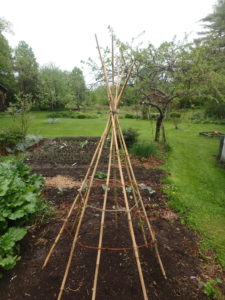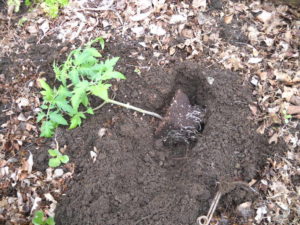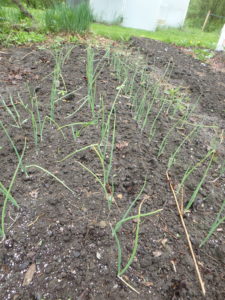It’s About Time to Plant the Vegetable Garden
One of the highlights of my year is planting my vegetable garden. It’s a time full of hope and anticipation as I nestle seedlings into the soil and sow seeds. I started many seeds indoors, growing tomatoes, peppers and more under lights. They are the right size now to plant.
Traditionally, Memorial Day weekend is the time many New Englanders plant things that are frost-sensitive. I prefer to plant tomatoes, peppers, squashes and other cold-adverse plants in June, even up to mid-June. I find that it’s better to wait until the soil really is well-warmed, and nights are warm, than rushing to plant. A night in the mid-thirties won’t kill your tomatoes, but it does set them back a bit. I find that tomatoes planted in June easily catch up with tomatoes planted earlier.
Of course, I have already planted some plants that don’t mind cold weather: lettuce, kale, onions, Brussels sprouts, broccoli and lettuce. These went in the ground in early May and are well established by now.
I built a nice bean teepee while waiting for summer to arrive, and will plant some Kentucky Wonder pole beans around it. I’ll wait until after any chance of frost has passed, as beans are frost-sensitive. I like pole beans because they keep on producing beans for many weeks if picked regularly. Bush beans produce beans for about 2 or 3 weeks, then are done.
To build the bean teepee I prepared a plot about 5 feet square, removing weeds and adding some compost. I had purchased 8 bamboo poles, each 7 feet tall. With one hand I held the poles together near their tops- say a foot from the top – and with the other I splayed out the bottoms of the poles one at a time. I tried to place the poles evenly, about 20 inches apart on the ground.
This project would be easier with 2 people working together, but I was alone in the garden and got the teepee made. I used a 2-foot length of thin copper wire to wrap around the place where all the poles crossed near the top of the teepee. String would also work fine.
In order to stabilize the teepee I then ran a string around each pole about 4 feet off the ground. I made sure the string was snug and then tied it to each pole using a clove hitch I learned in the Boy Scouts eons ago.
I did a second loop around the teepee with a flexible piece of grape vine, weaving in and out between poles, and then tying the vine to each pole with a short piece of string. I used grape vine because I had some, and I liked the way it looked, but you could stick with string if that is all you have.
When the time comes to plant my tomatoes I will take steps to ensure their roots develop well. Often tomatoes I start get long and “leggy” by the time I’m ready to plant. If I just planted the root ball, those tall stems would flop over. But I can convert that long stem into a root-bearing portion of the plant by burying it.
This can be done either by burying the root ball about 6 inches deep in a raised bed, or by planting the stem sideways. In either case I snip off the lower 2 to 4 branches, leaving leaves just at the top of an 8 to 12 inch stem.
To plant a tomato sideways, I dig a hole for the root ball and a trench for the stem. The top I bend and turn up, so those leaves are above the soil line. I cover the stem and root ball with soil, and I’m all done. You might fear you will break the stem when bending it, but that has only happened to me once in many years.
When planting tomatoes, don’t crowd them! Fungal diseases are a real problem most years, but can be minimized if the plants get good air circulation and lots of sunshine.
“Harden off” your tomatoes (and all plants) before putting them out. Ask at the garden center if the plants have been hardened off. If they’ve been in a greenhouse and never been outside in the sun, you’ve got to get them used to the sun. Greenhouse plastic reduces the sun’s ultraviolet rays and also protects plants from dehydrating in the wind.
If you buy plants that haven’t been hardened off and really, really want to get them in the ground, remember this: if you sunburn your plants, or dehydrate them, you will lose 2 weeks of growing time. You won’t kill them, but they will sulk. So don’t plant this weekend if the plants you buy aren’t hardened off.
Here’s how I harden off my tomatoes: I put them out for morning sun on my north-facing deck for 2 to 3 days, then in afternoon sun for 2 to 3 hours for a couple more days. Then they go out in the garden all day and night in their pots. Finally, I plant. I water the plants each day so they won’t dehydrate.
Gardening should be fun. It’s most fun when everything works and you harvest great vegetables. Don’t rush to get your plants in the ground, keep them well watered, and you should do just fine.
Follow Henry’s blog posts at https://dailyuv.com/





